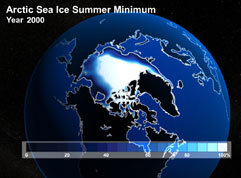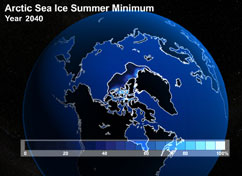Arctic sea ice melting 200% faster than previously thought
Arctic sea ice melting 200% faster than previously thought
mongabay.com
April 30, 2007
Arctic sea ice is melting far faster than previously believed reports a new study published in the May 1 issue of Geophysical Research Letters.
A comparison of newly available observational data to advanced simulations reveals that Arctic sea ice has been disappearing about three times faster
than the average rate of loss projected by computer models. The new research, conducted by Julienne Stroeve of the National Snow and Ice Data Center
(NSIDC) and his colleagues, shows that September sea ice extent retreated at a rate of about 7.8 percent per decade during the 1953-2006 period, not the 2.5 percent projected by simulations. The basis for the new data–a combination of satellite measurements and early aircraft and ship reports–is considered more reliable than the earlier records.
“This suggests that current model projections may in fact provide a conservative estimate of future Arctic change, and that the summer Arctic sea ice may disappear considerably earlier than IPCC projections,” Stroeve said.
  The image from 2000, based on simulations produced by the Community Climate System Model, shows the approximate extent of Arctic sea ice in September. The model indicates the extent of this late-summer ice could begin to retreat abruptly within several decades (top). By about 2040, the Arctic may be nearly devoid of sea ice during the late summer unless greenhouse gas emissions are significantly curtailed (bottom). Courtesy of UCAR. |
“Stroeve and his coauthors at NSIDC and at the National Center for Atmospheric Research (NCAR) speculate that the computer models may fail to capture the full
impact of increased carbon dioxide and other greenhouse gases in the atmosphere,” explained a statement from the National Snow and Ice Data Center.
“Whereas the models indicate that about half of the ice loss from 1979 to 2006 was due to increased greenhouse gases, and the other half due to natural variations in the climate system, the new study indicates that greenhouse gases may be playing a significantly greater role.”
Stroeve says the Arctic is particularly sensitive to climate change due to the albedo of sea ice, which helps reflect sunlight back into space, cooling the region. When sea ice melts, the dark areas of open water absorb the sun’s radiation, trigger a positive feedback loop that worsens melting.
Earlier this month scientists at NSIDC reported in the journal Science that winter sea ice in the Arctic was the second smallest area on record this year, narrowly missing the 2006 mark. Sea ice extent, or the area of ocean that is covered by at least 15 percent ice, was 5.7 million square miles (14.7 million sq km) in March, slightly higher than the record low of 5.6 million square miles (14.5 million sq km) measured in March 2006. March usually marks the maximum extent of sea ice in the Arctic.
“I’m not terribly optimistic about the future of the ice,” said Mark Serreze, author of the Science paper. “As greenhouse gases continue to rise, the Arctic will continue to lose its ice. You just can’t argue with the physics.”
Related articles